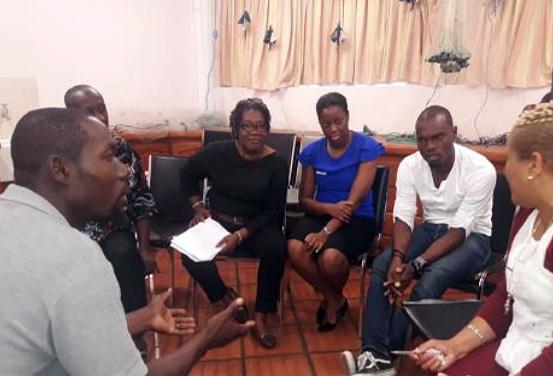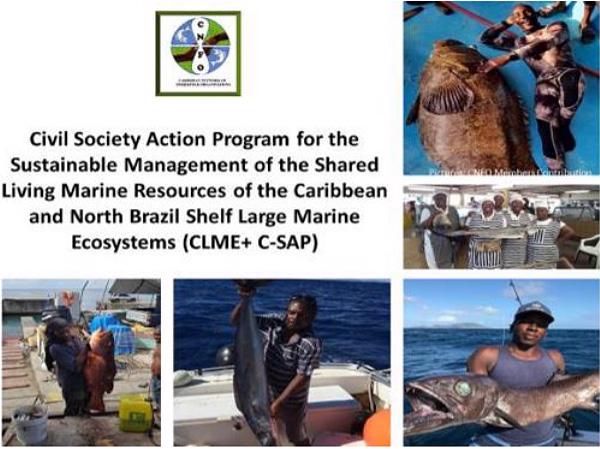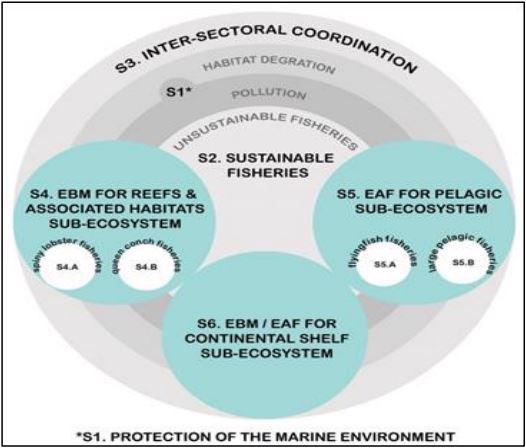
Engaging stakeholders in crafting a CLME+ Civil Society Action Programme and a sub-regional fishery management plan for Eastern Caribbean flyingfish
There are various initiatives, activities and programmes that have been put in place to aid with the implementation of the CLME+ Strategic Action Programme (SAP). This experience note highlights the best practices and lessons learned from efforts to engage civil society in the Caribbean region in CLME+ SAP implementation across selected CLME+ Sub-Projects. Lessons learned from the “Engaging Civil Society in CLME+ SAP Implementation” sub-project suggest that having financial support to effectively engage key stakeholders is critical to raising awareness and garnering support for the implementation of the Civil Society Action Programme (C-SAP). Participatory processes were also prominent in “Enhancing stakeholder participation in sub-regional management of flyingfish fisheries” sub-project. Developing guided communication and implementation plans for increasing stakeholder engagement is essential for Ecosystem-based Adaptation (EbA) projects implemented at multiple scales. Best practices include engaging civil society stakeholders in targeted discussions aimed at understanding issues from their perspectives and compiling the lessons learned.
The CLME+ region provides a multitude of goods and services that are critical to human well-being, livelihoods and socioeconomic development. The region’s marine ecosystems have an exceptionally high biodiversity, which also supports globally important ecological processes (e.g. fisheries, shipping, tourism and oil and gas exploration). Transboundary Diagnostic Analysis (TDA) studies conducted [by the CLME Project, 2009-2014] identified three pervasive issues affecting the CLME+ region: unsustainable fisheries, habitat degradation and marine pollution. These issues are further compounded by increased climate change and variability.
A challenge has been involving and engaging societal groups that have a direct stake in marine resources governance. The goal [of the CLME+ SAP] is to get all the diverse groups of stakeholders – governmental and non-governmental, including the private sector (from the different marine sectors e.g. fisheries, tourism, marine managed areas, transportation, energy, etc.) often with diverse, competing or conflicting interests to work well together to develop and pursue shared goals for the benefit of society. Civil society organisations, fisherfolk organisations and community enterprises play important roles in the conservation and sustainable use of the resources within the CLME+ region. This needs to be factored into regional plans and programmes and support provided for their effective engagement as partners in governance and management of coastal and marine resources.
| Meta data | |
|---|---|
| Regions | Caribbean |
| Scope | Regional |
| Ecosystem | LME |
| Categories | Large Marine Ecosystem |
| Thematic | Fisheries , Stakeholder Engagement , Strategic Action Plan (SAP) , Ecosystem-based Management , Public Awareness , Stakeholder Participation |
The CLME+ SAP uses an integrated, ecosystem-based management approach, with initial focus being placed on bringing together the various stakeholders. The SAP has been designed to resolve the [three] key transboundary issues and to address the impacts of climate change and variability in a progressively holistic and collaborative way.
Priority strategies and actions for improving transboundary governance and management of shared living marine resources have been identified and agreed upon. The CLME+ SAP has 6 strategies and 4 sub-strategies (Figure 1), which, as of June 2019, were endorsed by 25 countries and 6 overseas territories.
Activities under the CLME+ SAP have specific actions being monitored in order to assess the progress of SAP implementation, and to identify and learn from best practices across the CLME+ region. Table 1 gives examples of SAP actions and associated outcomes with the corresponding strategy/sub-strategy.
| CLME+ SAP Action | Outcomes under the SAP | Strategy/Sub-strategy |
|---|---|---|
| Governance | The establishment and strengthening of arrangements for the management and conservation of the Caribbean spiny lobster |
Strategy 4 – reef EBM: sub-strategy 4A – spiny lobster fisheries |
| Capacity building | The establishment and enhancement of institutional capacity to undertake and mainstream the valuation of ecosystem goods and services for improved decision-making and policy development |
Strategy 1 – protecting the marine environment |
| “On-the-ground” management | The implementation of the Sub-Regional Management Plan for the flyingfish fisheries in the Eastern Caribbean |
Strategy 5 – EAF for pelagics: sub-strategy 5A – fourwing flyingfish |
Outcomes and best practices can be developed when specific guidance is gleaned from lessons learned. The next section of this report highlights best practices from two CLME+ sub-projects in which civil society was engaged. The projects focused on:
- Engaging civil society in CLME+ SAP Implementation
- Enhancing stakeholder participation in sub-regional management of flyingfish fisheries.
1. Engaging Civil Society in CLME+ SAP Implementation
At the time of developing the CLME+ SAP efforts were made to ensure that there was widespread consultation with all relevant societal stakeholders. Despite these efforts, the CLME+ SAP mainly contains priority actions that would be undertaken from a governmental/public sector perspective. However, successful governance of the region’s shared living marine resources demands the involvement of not just publicsector actors, but also those societal groups that have a direct stake in the management and use of shared living marine resources. Recognising this, the CLME+ Project sought to engage and empower civil society and private sector stakeholders in the implementation of the CLME+ SAP through the development of a complementary CLME+ Civil Society Action Programme (C-SAP). This initiative was led by the Caribbean Natural Resources Institute (CANARI) under the Sub-project “Engaging Civil Society in CLME+ SAP Implementation”.
There were nine key steps in the process for the development of the C-SAP:
- Steps 1-3 focused on identifying and engaging key stakeholders/beneficiaries of the C-SAP: a participation and communication strategy was developed; a civil society organisations (CSOs) and small and micro enterprises (SMEs) database was developed along with a database of existing projects, programmes and initiatives which target CSOs and SMEs; and a regional workshop was held in January 2018 with 18 CSOs and SMEs from 14 countries; this helped stakeholders to identify priorities for the C-SAP
- Steps 4-7 focused on getting stakeholder input and validation in drafting the C-SAP: a draft C-SAP was circulated to the 18 CSOs and SMEs for review and validation and recommendations
- Steps 8-9 focused on outreach on the final CLME+ C-SAP and promoting the formal endorsement by CSOs and SMEs via: targeted emails, circulation on regional listservs, social media, virtual webinars, and face-to-face meetings. Small grants in the sum of $2,000 USD were awarded to each of the three leading CSOs to champion the promotion and endorsement of the C-SAP [by CSOs] in the CLME+ region. The three awarded CSOs were: The Caribbean Network of Fisherfolk Organisations (CNFO), CoopeSoliDar R.L. (in Costa Rica) and Nature Caribé. Table 2 highlights the key activities and outcomes from each CSO in endorsing and promoting the C-SAP. Although gender analysis was not a requirement for this project, all three organizations provided with small grants indicated that both women and men were involved in promotion and endorsement activities.
| Civil society organisation | C-SAP promotion and endorsement activity | Outcome |
|---|---|---|
| Caribbean Network of Fisherfolk Organisations |
In June 2019, three virtual learning circles were conducted with 16 of the 17 leaders of national fisherfolk organisations in each of the CNFO 17 member countries |
Used a virtual apprpach (i.e. webinars) for engaging the fisherfolk leaders. These webinars provided the opportunity for sharing and promoting information highlighting actions from the C-SAP that support priority issues to be addressed by fisherfolk in their respective countries |
| CoopeSoliDar R.L. |
Two one-day workshops were conducted in May 2019 with a total of 48 participants from 15 organisations, including CSOs and SMEs in Costa Rica |
Successfully shared information on the C-SAP allowing participants to have better understanding and appreciation for the role of local communities work and how it contributes to global goals. |
| Nature Caribé | A one-day workshop was held on May 8, 2019 in the Dominican Republic with 12 participants representing 11 different CSOs and SMEs. |
Successfully disseminated information on C-SAP, giving participants the chance to also share information and experiences on the challenges and problems facing the region's coastal marine resources Participants were able to consider other actions (e.g. micro-catchments and freshwater sources) that could be addressed under the C-SAP |
Programme activities and engagement
The CLME+ C-SAP prioritises actions for civil society involvement in addressing the three transboundary issues (unsustainable fisheries, habitat degradation and pollution) identified in the CLME+ SAP. These actions are aligned with strategies that include support for CSOs and SMEs to engage in the implementation of the CLME+ SAP through capacity building, strengthening enabling institutions, fostering partnerships and facilitating coordination.
The main objective for developing the C-SAP was to promote broader participation of, and contributions from civil society in implementing the 10-year CLME+ SAP. The project achieves this objective. Table 3 highlights the key activities, outputs and outcomes.
| Activity | Outcome | Output |
|---|---|---|
| Civil Society Action Programme (C-SAP) |
A C-SAP was developed to strengthen the role, participation and ownership of civil society in the implementation of the CLME+ SAP and CLME+ Project to achieve the long-term vision of the CLME+ region. This document was developed through consultation with civil society organisations, fisherfolk organisations and community enterprises, including at a regional workshop held January 16-19, 2018 in Trinidad & Tobago. |
|
| Small Grants Coordination Mechanism |
A Small Grants Coordination Mechanism was developed to support the implementation of priority actions identified in the C-SAP as well as to improve coordination among the different small grant programmes in the region. Small grant initiatives will contribute to increased stakeholder capacity and participation under the CLME+ SAP. A donor roundtable was held to input into designing the mechanism. |
Roundtable meeting report on the design of the small grant mechanism (in PDF and PowerPoint) |
| Small grants to support demonstration of the EAF & EBM |
Three small grants were provided to civil society organisations in the CLME+ region to implement actions under the C-SAP (see Table 2). A small grant was provided to build the capacity of community micro-enterprises in St. Kitts and Nevis sea moss farming. It demonstrates an alternative livelihood for EBM. CANARI and Department of Marine Resources joint national workshops on capacity building supported sea moss cultivation and commercialization. |
|
Best practices and lessons learned
- Stakeholder engagement and buy-in is critical to the successful adoption of the C-SAP by CSOs. The “Engaging Civil Society in CLME+ SAP Implementation” sought to ensure that civil society stakeholders were engaged in all stages of the C-SAP development process including, conceptualisation, review and promotion.
- Civil society is not a homogenous group and communication and engagement strategies must be designed to reflect the range of civil society actors involved in the management of key coastal and marine ecosystems in the CLME+ region. The in‐depth stakeholder analysis to identify key actors and their roles, undertaken by CANARI, proved a successful first step in engaging community leaders. The development of a participation and communication strategy to guide this engagement and foster commitment was also needed in the development and use of the C-SAP.
- Champions play a critical role in fostering buy-in and promoting implementation of the C-SAP at local levels (Steps 8 and 9 in the C-SAP development process).The small grant approach was particularly effective in reaching lower visibility CSOs at the local level that may have otherwise been missed by broader stakeholder engagement activities such as virtual webinars.
2. Enhancing stakeholder participation in the subregional management of the flyingfish fisheries
The Enhancing stakeholder participation in sub-regional management of flyingfish fisheries project of 2017 to 2019 supported the implementation of the Sub-regional Management Plan for Flyingfish (Sub-regional FMP) in the Eastern Caribbean. The overall sub-project was designed and led by the Caribbean Regional Fisheries Mechanism (CRFM). The stakeholder engagement component targeted the member countries Barbados, Dominica, Grenada, Saint Lucia, Saint Vincent and the Grenadines, and Trinidad and Tobago. This activity contributed to enhancing the governance arrangements for implementing an ecosystem approach to fisheries (EAF) for flyingfish under the CLME+ SAP. On behalf of the CRFM, the project was implemented by CANARI in partnership with UWI-CERMES.
There were five key activities and outputs under this project:
- Updated stakeholder identification and analysis;
- Development of awareness and educational products;
- Documentary on the Eastern Caribbean flyingfish fishery: A 16-minute mini-documentary “Spotlight on the Eastern Caribbean flyingfish fishery” was produced and the video link was shared with stakeholders. The aim was to improve awareness of the challenges around governance and management of flyingfish fisheries in the context of EAF and policy cycle;
- Knowledge Attitude and Practice (KAP) studies on key stakeholders’ involvement in the policy cycle; and
- National stakeholder consultations in at least four countries participating in flyingfish fisheries.
Project activities and engagement
Three national consultations along with a KAP study were conducted across four of the six project countries (Barbados, Saint Lucia, St. Vincent and the Grenadines and Trinidad and Tobago). Throughout the entire project, consultations were participatory and interactive and engaged stakeholders within the flyingfish fishery from government, non-government, civil society and the private sectors. A combination of facilitation techniques was used, these included plenary discussions and small group work to draw on participants’ knowledge and experiences. Stakeholders indicated that the various activities associated with the project, especially the national consultations and the communication products helped them to:
- Build awareness of the flyingfish fishery; issues affecting management and governance
- Improve their knowledge by becoming more familiar with key terms such as the Caribbean Large Marine Ecosystem, Ecosystem Approach to Fisheries, National Intersectoral Coordination Mechanisms, policy cycles and the subregional flyingfish fisheries management plan.
- Develop an overall understanding and appreciation for the fishery, which would likely improve their engagement in management actions.
Stakeholder Participation in this project proved to be very informative, beneficial and encouraging. It built awareness needed and gave a platform for better understanding the flyingfish fishery and supporting the sub-regional flyingfish fisheries management plan. Table 4 highlights the key outcomes from the project’s activities and outputs.
| Project activities and outputs | Outcome |
|---|---|
| Stakeholder identification and analysis |
|
| Awareness and education |
|
| KAP study |
|
| National consultations |
|
Best practices and lessons learned
- Stakeholder analysis and identification is critical to understanding who all the relevant stakeholders are, especially those among civil society (inclusive of fisherfolk) that should and could be engaged in the sub-regional management of the flyingfish fishery. This inclusion is especially important because these stakeholders are often marginalized and the ones in need of capacity building and support to enhance their representation and engagement in the overall governance of the flyingfish fishery.
- Developing a communication and awareness-building strategy was essential to garnering continued awareness of and buy-in for the implementation of the Sub-regional FMP. The use of different and more than one type of communication product (i.e. informational sheets and the documentary) was especially helpful in building awareness of and improving engagement of stakeholders in the sub-regional management of the flyingfish fishery. Additionally, different products and pathways are required for different audiences.
- Stakeholder awareness of the Sub-regional FMP, including its objectives and importance, need to be addressed continuously outside of the project, especially in light of recent revisions/updates to the plan. In particular, continued awareness efforts should consider communicating to a range of audiences, including non-technical persons; this proved to be quite helpful during the project.
- The KAP study helped stakeholders and the project facilitators to identify: 1) knowledge gaps, 2) existing perceptions and attitudes, 3) current practices in flyingfish fisheries management, while national stakeholder consultations facilitated increased engagement; providing stakeholders the opportunity to share and learn through meaningful discussions. The use of the KAP was important to having a baseline for evaluation, and also to inform targeting for stakeholder outreach and engagement. The national stakeholder consultations (in each country) were especially effective for including stakeholder input and getting recommendations to further improve the Sub-regional FMP. The overall effectiveness of these national consultations could be attributed to them providing the main platform for stakeholder learning and information- sharing in a participatory and interactive manner.
Lessons learned from the two sub-projects suggest that having financial support to secure effective engagement of key stakeholders is critical. This engagement usually requires diverse and guided communication strategies. The involvement of stakeholders in implementing action plans needs to be factored at multiple scales. Best practices include engaging civil society stakeholders in targeted discussions aimed at understanding issues from their perspectives. Future projects, programmes and initiatives should consider the aforementioned as essential to successfully including and engaging civil society.
More information can be accessed from the following websites:
- https://clmeplus.org
- https://canari.org/
- https://www.canari.org/wp-content/uploads/2017/08/csapbookletenglishfinal.pdf
- https://canari.org/clmepluscsap/
- https://canari.org/enhancing-stakeholder-participation-in-management-of-the-flyingfish-fishery/
- https://www.cavehill.uwi.edu/cermes/projects.aspx
- https://www.clmeproject.org/sap-overview/
- https://work.cgpsystems.cz/Small-tasks/hub-sequel/status-tracking-portal.php
- Patrick Debels (PatrickD@unops.org)

Image 1. Participants at one of the mini consultations held in Barbados.


Figure 1. CLME+ SAP 6 strategies and 4 sub-strategies. (Source: https://www.clmeproject.org/sap-strat/)

























